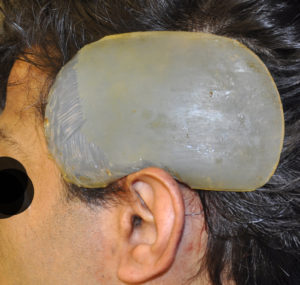The width of the head is determined by how wide it is above the ears. This is known as the temporal region and consists of a very uniquely shaped temporal bone and varying thicknesses of the temporals muscle over it. By the eye the temporal bone is very concave and the temporalis muscle is correspondingly very thick. (anterior temporal zone) Back by the ears, the temporal bone is much thinner, has a convex shape and the overlying temporalis muscle is much thinner. (zone 2)
While the side of the head is really comprised of both temporal zones, the perception of its width is determined more by the zone 2 region than zone 1. With a more narrow head width the shape of the head above the ears may be either a straight vertical line or even tilted in with a more narrow temporal line distance across the top of the head.

The size of head widening temporal implants suggests that they would be hard to surgically place, but they often are not much thicker than 5mm to 7mms. Because there are two sides to the head, a pair of head widening temporal implants causes a more substantial widening effect that one may think based on the numbers alone.
Dr. Barry Eppley
Indianapolis, Indiana


